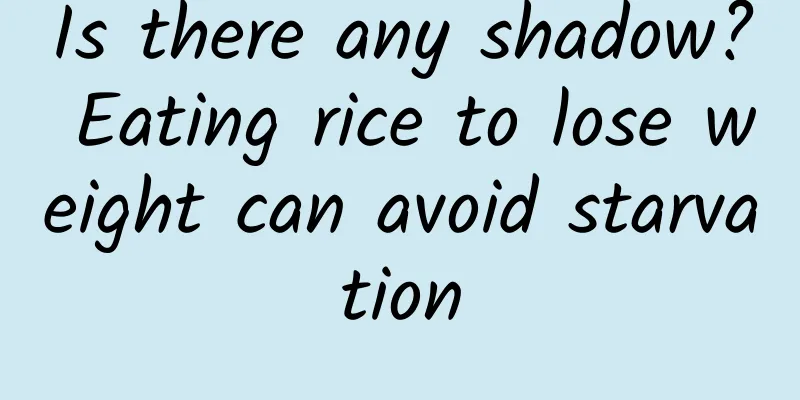Is there any shadow? Eating rice to lose weight can avoid starvation

|
Rice has always been an inconspicuous but indispensable delicacy. People who are afraid of it hide when they see it, fearing that they will get fat after eating it once. Is eating rice the culprit that causes obesity? How many calories are in a bowl of rice? How to eat rice to lose weight without going hungry? 1. Re-understanding rice We eat rice every day, so do we really need to learn more about it? It must be said: It is very necessary! Because many people think that rice has little nutritional value other than carbohydrates. Some even think that it is the "natural enemy of weight loss" that is more likely to cause obesity than hamburgers and steaks. In fact, it is much better than you think. 2. What nutrients are in rice?
3. What can you get from eating 100g of rice?
4. Know how much you eat at a glance
5. The most popular diet
Japanese eel rice, known as the "energizing food", is full of protein and is indeed a vital choice!
The rich zinc nutrition of seaweed, combined with the oil and fatty acids of tuna, and the combination with whole grain rice, makes a brain-boosting meal. 6. Rice is a good helper for weight loss In fact, compared to bread and noodles as staple foods, white rice is the carbohydrate that is least likely to make you gain weight. The reason is that rice is easier to make people feel full, and it contains B vitamins and linoleic acid that help fat metabolism. Use rice as the staple food, with plenty of vegetables, a small amount of meat and oil. It can help you lose weight while maintaining a balanced diet. 7. How to eat rice to lose weight without going hungry To reduce calorie intake, you can add foods rich in soluble fiber such as oats and barley to rice. Soluble dietary fiber has a strong ability to absorb and swell after absorbing water. It can form sol and gel after absorbing water, slowing down the emptying rate of chyme in the stomach. In addition, you can also add foods rich in gelatin, such as kelp, fungus, seaweed, and konjac. The gum in plants has the function of inhibiting fat absorption, nourishing and lubricating the intestines, and helping defecation. Mixing black rice, brown rice, bamboo shoots, ferns and other foods rich in dietary fiber with rice and cooking them can not only slow down the digestion of carbohydrates but also increase the feeling of fullness. Bean rice, which is made by mixing rice with various beans such as red beans and yellow beans in a 1:1 ratio, not only plays the complementary role of protein, but also significantly improves the feeling of fullness. Therefore, the same amount of rice can be reduced by adding different ingredients, thereby reducing the absorption of calories. Fortified rice is good for the body and skin, and can prevent constipation, acne, hyperlipidemia, and cardiovascular and cerebrovascular diseases. However, for those with weak gastrointestinal function and digestive tract diseases, the intake of dietary fiber should be controlled. Source: 39 Health Network www.39.net Please do not reprint without written authorization |
<<: Get more sun in winter to effectively control appetite
>>: 8 must-have low-calorie snacks for office workers
Recommend
How should patients with pelvic inflammatory disease eat?
Modern people advocate health preservation. Every...
Surgical treatment of congenital absence of vagina
Patients with congenital absence of vagina suffer...
What are the precautions for surgical abortion? Pay attention to these 5 points
After the abortion, you should pay attention to r...
Solutions for excessive bleeding after medical abortion
If the fetal sac is seen to be expelled during th...
Causes of postmenopausal bleeding
Normally, it is a benign disease, such as cervica...
Eating sandwiches for breakfast is nutritious and healthy! Add 5 weight-loss-promoting fillings, so you won’t get fat after eating
It is a common habit for people to eat sandwiches...
How to take care of cervical erosion? Summary of 5 key points of care for cervical erosion in women
As a common gynecological disease, women may suff...
Can I eat peaches if I have pelvic inflammatory disease? There are great benefits
For some women with pelvic inflammatory disease, ...
What can be checked by color Doppler ultrasound of the uterine appendages? Can color Doppler ultrasound detect adnexitis?
Adnexitis is a common gynecological disease, but ...
Some tips are also helpful for treating dysmenorrhea
Dysmenorrhea often occurs in women, which has an ...
Detox and lose weight in spring by eating 100-calorie, high-fiber sweet potato dishes
The ancients believed that among the four seasons...
Expert introduction: What are the main hazards of chronic cervicitis?
The answer to the harm of chronic cervicitis is g...
The main causes of uterine fibroids
We may not know much about uterine fibroids. What...
Will uterine effusion get worse?
Will uterine effusion get worse? Uterine effusion...
How to avoid endometriosis
Endometriosis is a gynecological disease that cau...









